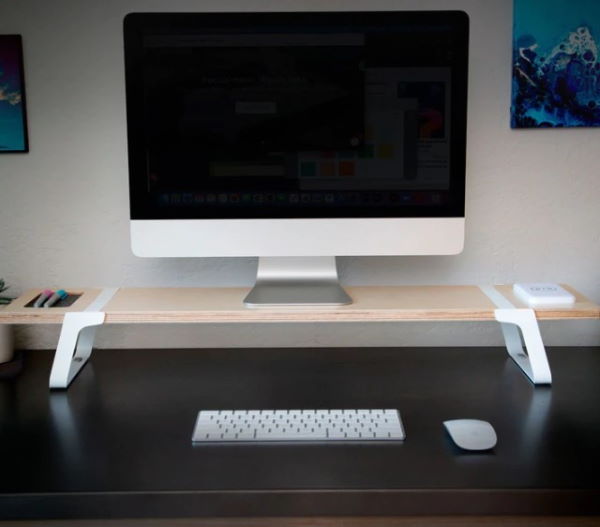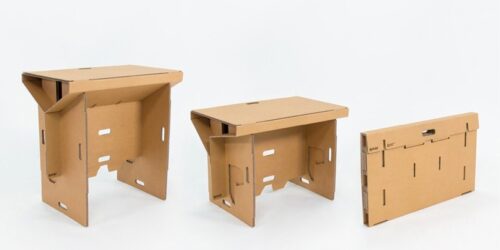How to Set Up Your Desk Ergonomically for Working

A comfortable and ergonomic workspace can increase your productivity and make you feel your best even after a long day at work. With more people spending their working hours at a desk, the value of desk ergonomics cannot be overstated. It makes you feel good, allowing you to get more work done and prevent chronic pains and aches in your neck, lower back, and shoulders.
Desk Ergonomics: What You Need
If you sit at a desk for work (especially for long periods of time), you shouldn’t accept back pain and sore necks as part of your work-life. Proper desk ergonomics can address this problem and correct your position.
Before you delve into what you need for an ergonomic workstation, you must first know the basics of an ergonomic desk setup. Take note of these tips when setting up your desk or home office:
- Your eyes should be approximately 2-3 inches below the top of the monitor.
- The monitor must be an arm’s length away (at least).
- Keep your head, neck, and shoulders straight. You should feel relaxed throughout while seated.
- Keep your elbows bent at a 90-degree angle. Keep them to your sides at all times.
- Rest your wrist on the keyword and not at an angle.
- Your knees must be at the same level as your hips (or slightly below, but not over).
- You must slightly recline your chair at no more than an angle of 120 degrees.
- Your feet should be able to touch the ground. If not, use a footrest.
Now that you understand the basics of an ergonomic workstation, it’s time to get set up. The following are what you need to build an ergonomic workspace at home or in the office.

1. Ergonomic Chair
Choosing the chair for your office might be one of the most important decisions you will have to make. Your chair must support the natural curvature of your spine.
You must adjust the chair’s height to allow your feet to rest flat on the floor and keep your thighs parallel to the ground. For this reason, it is a good idea to invest in an adjustable chair so you can find the most comfortable height and position relative to your desk.
If you have an existing office chair that is not ergonomic in design, invest in a seat cushion or pillow for lumbar support. The pillow, for instance, can help correct your posture, so you are seated properly instead of leaning forward, causing your spine to get slumped.
2. Office Desk
Like your chair, your office desk must be ergonomically designed to promote good posture and avoid chronic pains. If possible, customize your desk to a height that is suited to your own height. It should be of adequate height to rest your feet on the floor but without cramping your legs beneath the desk.
The best desk should also help you maintain a neutral position for your wrist. It should naturally support the position of your wrist as it rests on the keyboard while you are typing. The ideal height for most office desks would be 28-30 inches (recommended for anyone 5 feet 10 inches and above).
If you cannot find a desk suited to your height or are unable to customize one, you can try a few solutions. First, you can add a footrest so that your feet are not dangling off the chair. Second, you can mount a keyboard tray to your desk so that your wrists are in a neutral position.
An adjustable height desk is one of the essential tools for setting up an ergonomic workspace. It offers the best fit for everyone because the height can be adjusted up or down, depending on the user’s height. It also allows you to switch between sitting or standing while working.
3. Keyboard and Mouse
These two components in an office desk should go hand in hand. When setting up your keyboard and mouse, your mouse should be within easy reach. At the same time, the mouse should not be too big or too small for your hands; it should fit just right. It pays to invest in a responsive, high-quality mouse to avoid causing injuries due to repetitively straining your fingers and wrists. You can also look at ergonomic accessories designed to reduce fine wrist and finger movements.
The keyboard is another crucial component when setting up an ergonomic workspace. You might not realize it, but the position of traditional keyboard designs forces your shoulders to move inward and closer together. This causes a lot of strain on your shoulders in the long run. If you can find them, choose an adjustable ergonomic keyboard. This office accessory is designed to keep your hands a shoulder-width apart.
4. Computer Monitor
Positioning the computer monitor about an arm’s length away from you helps combat eye strain. The possibility of eye strain happens when you stare at your computer screen for an extended period of time. To combat this, you should adjust your screen’s brightness level.
The height at which you position the monitor is also crucial to desk ergonomics. Your eyes should be 2-3 inches below the top portion of the monitor. This level ensures you can keep your head and neck straight. It can cause a lot of strain to your neck if you position the monitor too high or too low.
5. Lighting
Good lighting is a critical element of an ergonomic workstation. Good lighting can minimize eye strains and promote a sense of well-being.
Set up your office or desk somewhere near a window if you can. Access to natural daylight or outdoor views enables your eyes to relax and rest from staring at your computer all day long.

Importance of Desk Ergonomics
Being comfortable is an obvious benefit of setting up an ergonomic workstation. But perhaps a more important benefit is the ability to prevent repetitive strain injury (RSI). There are many types of RSI, and carpal tunnel syndrome is one of the most common. Carpal tunnel syndrome results from fine movements on the wrist and fingers, resulting in nerve compression in the arm.
Aside from setting up your office desk to maintain correct posture, make sure you get frequent breaks. You should avoid spending all 8 hours of your workday seated. Get up whenever you can and move around. Do some light stretching, if you’re able. It is also a good idea to set up a standing desk so you can enjoy the benefits of standing while working.






